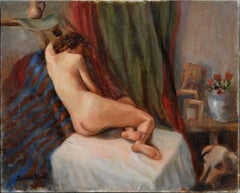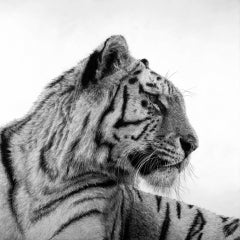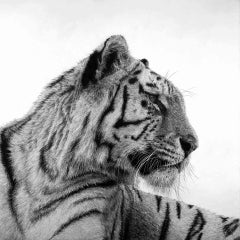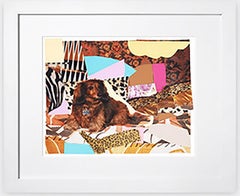David Hunt Art
to
2
1
1
2
1
1
2
Overall Height
to
Overall Width
to
1
1
2
2
2
1
1
1
1
2
1
3
7,006
3,388
2,513
1,212
2
2
2
1
1
Artist: David Hunt
Reclining Nude Figure
By David Hunt
Located in Soquel, CA
This original painting is a beautifully depicted nude figure study in a cozy interior space with southwest elements by San Jose, California artist David D....
Category
1990s American Impressionist David Hunt Art
Materials
Oil, Linen
Tiger 1, David Hunt, Limited Edition Print, Animal Artwork, Black And White Art
By David Hunt
Located in Deddington, GB
David Hunt
Tiger 1
Limited Edition Giclee Print
Edition of 10
Framed Size: H 84cm x W 84cm x D 3.5cm
Sold Framed
Please note that in situ images are purely an indication of how a piece may look.
Tiger 1 is an original work on paper by artist, David Hunt.
David Hunt comments "after a career that has ranged from working on oil rigs in Africa and Central Asia to running my own business building shepherd's huts for private clients I have now returned to my first loves of drawing and draftsmanship. I am mostly self taught and have studied intaglio etching techniques with john Howard R.E. and Melvyn...
Category
21st Century and Contemporary Realist David Hunt Art
Materials
Giclée
Tiger 1, David Hunt, Animal Art, Realist Print, Affordable Artwork
By David Hunt
Located in Deddington, GB
David Hunt
Tiger 1
Limited Edition Giclee Print
Edition 10
Framed Size: H 84cm x W 84cm x D 3.5cm
Sold Framed
Please note that in situ images are purely an indication of how a piece ...
Category
21st Century and Contemporary Photorealist David Hunt Art
Materials
Paper, Giclée
Related Items
Female Bather (Nude Women)
Located in Wilton Manors, FL
Ann Brockman (1895–1943) was an American artist who achieved success as a figurative painter following a successful career as an illustrator. Born in California, she spent her childhood in the American Far West and, upon marrying the artist William C. McNulty, relocated to Manhattan at the age of 18 in 1914. She took classes at the Art Students League where her teachers included two realist artists of the Ashcan School, George Luks and John Sloan. Her career as an illustrator began in 1919 with cover art for four issues of a fiction monthly called Live Stories. She continued providing cover art and illustrations for popular magazines and books until 1930 when she transitioned from illustrator to professional artist. From that year until her death in 1943, she took part regularly in group and solo exhibitions, receiving a growing amount of critical recognition and praise. In 1939 she told an interviewer that making money as an illustrator was so easy that it "almost spoiled [her] chances of ever being an artist."[1] In reviewing a solo exhibition of her work in 1939, the artist and critic A.Z Kruse wrote: "She paints and composes with a thorough understanding of form and without the slightest hesitancy about anatomical structure. Add to this a magnificent sense of proportion, and impeccable feeling for color and an unmistakable knowledge of what it takes to balance the elements of good pictorial composition and you have a typical Ann Brockman canvas."[2]
Early life and training
Brockman was born in Northern California in 1895 and spent much of her youth in nearby Oregon, Washington, and Utah.[1][3] She met the artist William C. McNulty in Seattle where he was employed as an editorial cartoonist. They married in March 1914 and promptly moved to Manhattan where he worked as a freelance illustrator.[4][5] At the time of their marriage, Brockman was 18 years old.[6] Over the next few years, her career generally followed that path that her husband had previously taken. His art training had been at the Art Students League beginning in 1908; she began her training there after moving to New York in 1914.[1] After an early career as an editorial cartoonist, he freelanced as a magazine and book illustrator beginning in 1914; she began her career as a magazine and book illustrator in 1919.[7] He embarked on a teaching career in the early 1930s and not long after, she began giving art instruction.[8][9] While they both adhered to the realist tradition in art, their usual subjects were different. His prominently depicted urban cityscapes in the social realist whereas hers generally focused on rural landscapes. He was best known for his etchings and she for her oils and watercolors.[8][10]
Brockman returned to the Art Students League in 1926 to take individual instruction for a month at a time from George Luks and John Sloan.[1] Despite their help, one critic said McNulty's "sympathetic encouragement and guidance" was more important to her development as a professional artist.[11]
Career in art
In the course of her career as illustrator, Brockman would sometimes paint portraits of celebrities before drawing them, as for example in 1923 when she painted the French actress Andrée Lafayette who had traveled to New York to play title role in a film called Trilby.[12] She would also sometimes accept commissions to make portrait paintings and in 1929 painted two Scottish terriers on one such commission.[13] During this time, she also produced landscapes. In 1924 she displayed a New England village street scene painting in the Second Annual Exhibition of Paintings, Watercolors, and Drawings in the J. Wanamaker Gallery of Modern Decorative Art.[14] Available sources show no further exhibitions until in 1930 a critic for the Boston Globe described one of her portraits as "well done" in a review of a Rockport Art Association exhibition held that summer.[15]
Between 1931 and her death in 1943, Brockman participated in over thirty group exhibitions and five solos.[note 1] Her paintings appeared in shows of the artists' associations to which she belonged, including the Rockport Art Association, Salons of America, Society of Independent Artists, and National Association of Women Painters and Sculptors.[17][19]Between 1932 and 1935, her paintings appeared frequently in New York's Macbeth Gallery.[20][23][25][27] She won an award for a painting she showed at the Art Institute of Chicago in 1940.[41] In 1942, the Whitney Museum bought one of the paintings she showed in its Biennial of that year.[10] Critical praise for her work steadily increased during the decade that ended with her untimely death in 1943. In 1932, her painting called "The Camera Man" was called "a clever piece of illustration."[21] Three years later, a painting called "Small Town" gave a critic "the impression of freshness, honesty, and skill".[29] In 1938, a critic described her "Folly Cove" as "masterful" and said "Pigeon Hill Picnic" was "sustained by excellence of execution".[48] At that time, Howard Devree of the New York Times saw "evidence of gathering powers" in her work and wrote "she imparts a dramatic feeling to landscape. She even manages this time to do trees touched by Autumn tints without calendar effect, which is no small praise."[51] Three years later, a Times critic reported Brockman had "set herself a new high" in the watercolors she presented,[52] and another critic said the gallery where she was showing had not "for some time" shown "so outstanding a solo exhibitor as Ann Brockman."[2] Shortly before her death, a critic for Art News maintained that she was "one of America's most talented women painters".[46]
After she had died, a critic said Brockman's paintings "displayed real power", adding that she was "highly rated among the nation's professional artists" and was known to give "aid and encouragement, always with a smile," both artists and to her students.[10] in reviewing the memorial exhibition at the Kraushaar Galleries held in 1945, reviewers wrote about the strength and vibrancy of her personality, the quality of her painting ("every bit as good, possibly better than people had thought"),[53] called her "one of the best of our twentieth century women painters", and credited "her sense of the vividness of life" as a contributor to "the unusual breadth that is so characteristic of her work.[11] One noted that her work was "widely recognized throughout the country" and could be found in the collections of prominent museums, including the Metropolitan Museum of Art, the Whitney Museum of American Art, and the Art Institute of Chicago.[54] Writing in the Times, Devree wrote, "even those who had followed the steady growth of this artist for more than a decade, each successive show being at once an evidence of new achievement and an augury of still better work to come, may well be surprised at the combined impact of the selected paintings in the present showing,"[55] and writing in the Brooklyn Daily Eagle, A.Z Kruse said she had made "extraorginary accomplishments", painted with "inordinate distinction" showing a "lyrical majesty," and possessed "a keen esthetic sense which did not deviate from truth."[54]
Artistic style
(1) Ann Brockman, undated drawing, black chalk on paper, 18 x 22 inches
(2) Ann Brockman, High School Picnic, about 1935, oil on canvas, 34 1/4 x 44 1/4 inches
(3) Ann Brockman, untitled landscape, about 1943, watercolor and pencil on paper, 15 1/4 x 22 1/2 inches
(4) Ann Brockman, North Coast, undated watercolor, 21 1/2 x 30 inches
(5) Ann Brockman, On the Beach, 1942, watercolor on paper, 16 1/2 x 20 inches
(6) Ann Brockman, Lot's Wife, 1942, oil on canvas, 46 x 35 inches
(7) Ann Brockman, New York Harbor, 1934, watercolor on paper, 13 1/2 x 19 1/4 inches
(8) Ann Brockman, Youth, 1942, oil on board, 13 1/2 x 11 1/2 inches
Brockman was a figurative painter whose main subjects were rural landscapes and small-town and coastal scenes. She worked in oils and watercolors, becoming better known for the latter late in her career. Most of her paintings were relatively small. Although she made figure pieces infrequently, the nudes and circus and Biblical scenes she painted were seen to be among her best works. In 1938, Howard Devree wrote: "Her gray-day marines and coast scenes are familiar to gallery goers and are favorites with her fellow artists. Her figure pieces have attained a sculptural quality without losing warmth or taking on stiffness. One spirited circus incident of equestriennes about to enter the big tent compares not unfavorably with many of the similar pictures by a long line of painters who have been fascinated by the theme. She imparts a dramatic feeling to landscape. She even manages this time to do trees touched by Autumn tints without calendar effect, which is no small praise."[51] Similarly, a critic for Art Digest wrote that year: "Fluently and virilely painted, [her] canvases suggest a close affinity between nature and humans. The artist takes her subjects out in the open where they may picnic or bathe with space and air about them. A fast tempo is felt in the compositions of restless horses and nimble entertainers busily alert for the coming performance. Miss Brockman is also interested in portraying frightened groups of people, hurrying to safety or standing half-clad in the lowering storm light."[56]
Her palette ranged from vivid colors in bright sunlight to somber ones in the overcast skies of stormy weather. Of the former, one critic spoke of the rich colors and "sun-drenched rocks" of her coastal scenes and another of her "summery landscapes of coves and picnics."[11][50] Of the latter, Howard Devree said she "painted so many moody Maine coast vignettes of lowering skies and uneasy seas that artists have been heard to refer to an effect as 'an Ann Brockman day'".[57]
Brockman's handling of Biblical subjects can be seen in the oil called "Lot's Wife", shown above, Image No. 6. Her watercolor called "On the Beach" and her oil portrait called "Youth" may both indicate the "sculptural quality" that Devree said was typical of her figure pieces (Image No. 8, above).
An example of Brockman's bright palette in a typical summer theme is the oil painting called "High School Picnic" shown above, Image No. 2. Next to it is a painting, an untitled landscape of about 1943 whose medium, watercolor on paper, shows off the sunny palette she often used (Image No. 3).
Among the darkest of her works was an untitled 1942 drawing she made in black chalk (shown above, Image No. 1). In a book called Drawings by American Artists (1947), the artist and art editor Norman Kent noted that this study influenced her painting through its use of "forms" that were "elastic" and suggested "color". He said its "massing of dark and light" created "a definite mood" that was "impressionistic" and had "the strength of a man's work".[58] Brockman's undated watercolor called "North Coast" (shown above, Image No. 4) is an example of the paintings to which Kent referred.
Illustrator
(9) Ann Brockman, cover, March 12, 1917, Every Week magazine
(10) Illustration of an article, "The Taking of a Salient" by Henry Russell...
Category
1930s American Impressionist David Hunt Art
Materials
Oil
Portrait de Priscilla Le Petit Chien
By Mickalene Thomas
Located in New York, NY
Mickalene Thomas
Portrait de Priscilla Le Petit Chien, 2012
Pigment print on 100% cotton rag paper
Edition 148/150
Frame included with official COA affixed to the back
Hand numbered from the edition of only 150 with plate signed official Certificate of Authenticity on the verso of the frame.
This exquisite print, published in 2012, is based on an original collage made by the artist of her long-haired miniature dachshund (a gift from fellow artist Kehinde Wiley), Priscilla. Highly acclaimed contemporary art star Mickalene Thomas created this collage specifically for children- though adults will appreciate it as well - as will pet lovers!
Portrait de Priscilla Petit Chien features Priscilla, Thomas' own dog who frequently attends the artist's photoshoots. This limited edition archival pigment print is printed on cotton rag paper and accompanied by a plate (facsimile) signed and uniquely hand numbered certificate of authenticity. It is matted and comes in a 1"-deep wooden frame with Plexiglas®. Wired for hanging. Edition of 150. This professionally framed limited edition pigment print on 100% cotton rag paper is based on an original collage made by the artist of her long-haired miniature dachshund (a gift from fellow artist Kehinde Wiley), Priscilla. The print is matted and comes in a white wooden frame (16" x 19" x 1") with Plexiglas, wired for hanging. Dimensions: 11" x 14" sheet, 9-1/4" x 12" image.
Mickalene Thomas Biography:
Mickalene Thomas (b. 1971, Camden, NJ; lives and works in Brooklyn, NY) makes paintings, collages, photography, video, and installations that draw on art history and popular culture to create a contemporary vision of female sexuality, beauty, and power. Blurring the distinction between object and subject, concrete and abstract, real and imaginary, Thomas constructs complex portraits, landscapes, and interiors in order to examine how identity, gender, and sense of self are informed by the ways women are represented in art and popular culture. Rhinestones—the artist’s signature material and a symbol of femininity—serve as an added layer of meaning and a metaphor of artifice. Thomas uses rhinestones to shade and accentuate specific elements of each painting, while subtly confronting our assumptions about what is feminine and what defines women.
Thomas has drawn inspiration from multiple artistic periods and cultural influences throughout Western art history, particularly the early modernists such as Jean-Auguste-Dominique Ingres, Pablo Picasso, Henri Matisse, Edouard Manet, and Romare Bearden. She models her figures on the classic poses and abstract settings popularized by these modern masters as a way to reclaim agency for women who have been presented as objects to be desired or subjugated. Though Thomas draws from a number of time periods and genres, her use of pattern and domestic spaces often references various periods throughout the 1960s to the 1980s. This was a time of immense social and political conflict, change, and transformation—the civil rights movement, the black is beautiful movement, and the second wave of feminism—during which many women, particularly African-Americans, rejected and redefined traditional standards of beauty.
Thomas received a BFA from the Pratt Institute, Brooklyn, NY, in 2000 and an MFA from Yale University School of Art, New Haven, CT, in 2002. Solo exhibitions of her work have been organized at The Dayton Art Institute, OH (forthcoming, 2018); Henry Art Gallery, Seattle, WA (forthcoming, 2018); Pomona College Museum of Art, Claremont, CA (forthcoming, 2018); Georgia Museum of Art, Athens, GA (forthcoming, 2017); Newcomb Art Museum, Tulane University, New Orleans, LA (2017); Spelman College Museum of Fine Art, Atlanta, GA (2017); Museum of Contemporary Art, Los Angeles (2016); Aspen Art Museum, CO (2016); Aperture Foundation, New York (2016); George Eastman Museum, Rochester, NY (2014); Brooklyn Museum, New York (2012-13); Santa Monica Museum of Art (2012); Institute of Contemporary Art, Boston (2012); Hara Museum of Contemporary Art, Tokyo (2011); and La Conservera Centro de Arte Contemporaneo, Ceuti, Spain (2009). Select group exhibitions featuring her work include Third Space / Shifting Conversations About Contemporary Art, Birmingham Museum of Art, AL (2017); Constructing Identity: Petrucci Family Foundation Collection of African-American Art, Portland Art Museum, ME (2017); The Color Line: African American Artists and the Civil Rights in the United States, Musée du quai Branly, Paris (2016); SHE: International Women Artists, Long Museum, Shanghai (2016); No Man’s Land: Women Artists from the Rubell Family Collection, Rubell Family Collection, Miami, traveled to the National Museum of Women in the Arts, Washington, DC (2015); 30 Americans, Corcoran Gallery of Art, Washington, DC (2011), which has traveled extensively around the United States (2011-2017, ongoing); and Americans Now, National Portrait Gallery, Washington, DC (2010). Thomas’ work is in numerous international public and private collections, including The Museum of Modern Art, New York; San Francisco Museum of Modern Art; Solomon R. Guggenheim Museum, New York; Whitney Museum of American Art, New York; Museum of Fine Arts, Boston; Art Institute of Chicago; MoMA PS1, New York; Brooklyn Museum, New York; Studio Museum in Harlem, New York; Yale University Art Collection, New Haven, CT; and Hara Museum of Contemporary Art, Tokyo.
Thomas has been awarded multiple prizes and grants, including the USA Francie Bishop Good & David Horvitz...
Category
2010s Realist David Hunt Art
Materials
Digital Pigment, Permanent Marker, Laid Paper
"Seated Nude" Nude Portrait of a Woman Oil on Board Painting by American Artist
By Louis Bouché
Located in New York, NY
This is a wonderful example of Louis Bouché's charming Nude portraits. The artist was truly a master of capturing the energy of the times, and character o...
Category
Mid-20th Century American Impressionist David Hunt Art
Materials
Board, Oil
Pablo Picasso 'Picador' (A. R. 160) Bullfighter Madoura Plate 1952
By Pablo Picasso
Located in Miami, FL
PABLO PICASSO (1881-1973)
Picador (A. R. 160)
Terre de faïence plate, 1952, from the edition of 500, incised 'Edition Picasso', partially glazed and painted, with the Edition Pica...
Category
1950s Modern David Hunt Art
Materials
Ceramic
"Bathsheba" Oil Painting
Located in Denver, CO
Clyde Steadman's "Bathsheba" is an original, handmade oil painting that depicts an impasto painting of a nude female model in an interior setting.
Category
2010s American Impressionist David Hunt Art
Materials
Oil, Panel
Spanish Gown, Standing Nude Figure, American Impressionist, 1920s, Oil on Board
Located in Wiscasset, ME
"Spanish Gown" is possibly signed lower right. A painterly American Impressionist work beautifully captures a nude woman stepping from a golden gown. The painting is reminiscent of t...
Category
20th Century American Impressionist David Hunt Art
Materials
Oil, Board
Looking Out, Oil Painting, Impressionism, LA Academy of Figurative Art
Located in Houston, TX
Looking Out by Vadim Zang is an oil painting that is 18" x 14"". This is painted in the style of Impressionism.
Vadim Zanginian was born in Armenia in 1965. He is a graduate from A...
Category
2010s American Impressionist David Hunt Art
Materials
Oil, Canvas
H 18 in W 14 in D 1 in
Modernity - Lithograph - After Raoul Dufy
By (after) Raoul Dufy
Located in Collonge Bellerive, Geneve, CH
(after) Raoul Dufy
Lithograph after a watercolor, published in the book "Lettre à mon peintre Raoul Dufy." Paris, Librairie Académique Perrin, 1965.
Printed signature
Dimensions: ...
Category
1940s Fauvist David Hunt Art
Materials
Lithograph
Three Cocker Spaniels original signed etching by Leon Danchin
By Leon Danchin
Located in Paonia, CO
Three Cocker Spaniels is an original color etching by well known French sports artist Leon Danchin. The three Spaniels are in waiting mode with two lying down and one sitting ...
Category
1930s Realist David Hunt Art
Materials
Etching
White-throated Capuchin Monkey: Framed Audebert 18th C. Hand-colored Engraving
Located in Alamo, CA
This is a framed 18th century folio-sized colored stipple engraving with hand-finishing entitled "Le Sai a gorge blanche. Variete A. Buff. Simia capucina. v.a.", which was drawn and engraved by Jean Baptiste Audebert...
Category
Late 18th Century David Hunt Art
Materials
Engraving
H 30.25 in W 22.63 in D 1 in
Respite
By John McLeod
Located in Denver, CO
Nude reclining figure in candlelight
Category
2010s American Impressionist David Hunt Art
Materials
Panel, Oil
"Annunciation" Oil Painting
Located in Denver, CO
Clyde Steadman's "Annunciation" is an original, handmade oil painting that depicts an impasto painting of a nude female model in an interior bathroom setting.
Category
2010s American Impressionist David Hunt Art
Materials
Oil, Panel
David Hunt art for sale on 1stDibs.
Find a wide variety of authentic David Hunt art available for sale on 1stDibs. You can also browse by medium to find art by David Hunt in digital print, giclée print, inkjet print and more. Much of the original work by this artist or collective was created during the 21st century and contemporary and is mostly associated with the Photorealist style. Not every interior allows for large David Hunt art, so small editions measuring 20 inches across are available. Customers who are interested in this artist might also find the work of Noel Howard, Theo Wujcik, and Jim Smyth. David Hunt art prices can differ depending upon medium, time period and other attributes. On 1stDibs, the price for these items starts at $650 and tops out at $1,318, while the average work can sell for $1,162.




